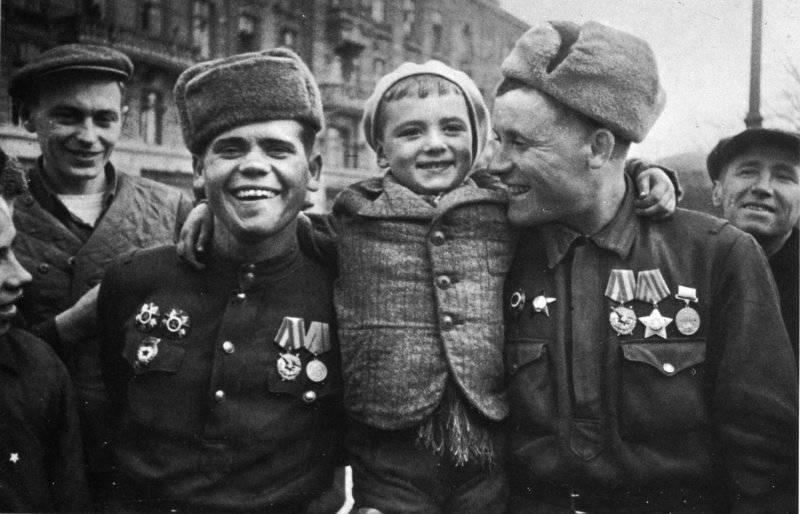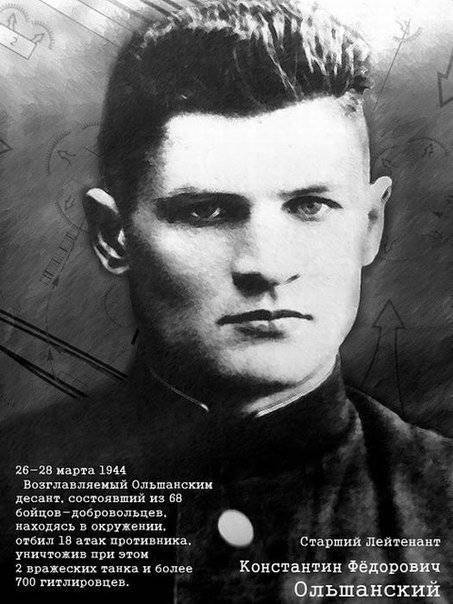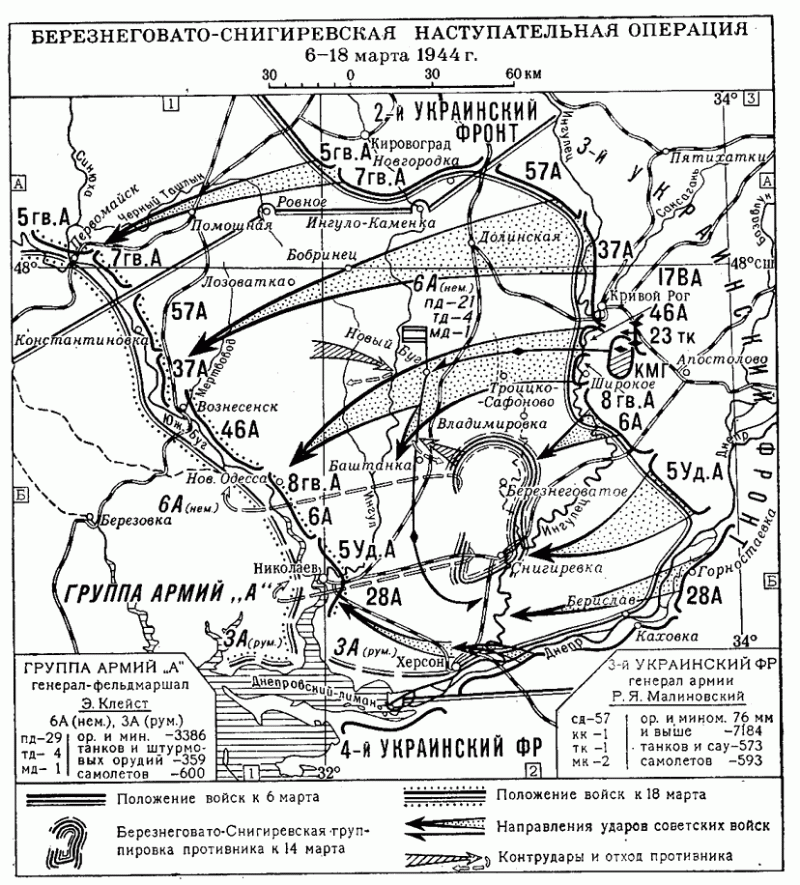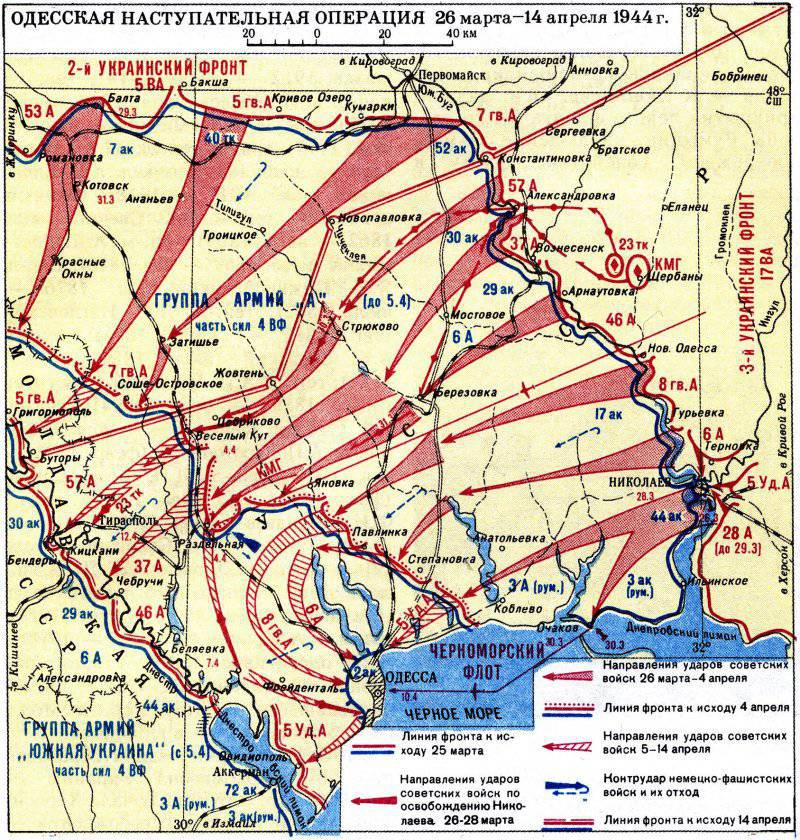The third Stalinist blow. The liberation of Odessa

Soviet soldiers with a child in liberated Odessa
The situation before the operation
The Odessa operation was preceded by the Bereznegovatno-Snigirevskaya operation (March 6-18, 1944). During it, the troops of the 3rd Ukrainian Front defeated the forces of the German 6th Army. Nine German divisions were defeated. As the Soviet newspaper Pravda noted, the second composition of the 6th Army repeated the fate of the first 6th Army, which was destroyed near Stalingrad. Significant German group threatened with complete death. Therefore, the German command on March 12 was forced to withdraw all the forces of the 6th Army to the border of the Southern Bug River. Parts of the 17th and 44th German army corps, suffering heavy losses and throwing heavy weapons, managed to break through the Southern Bug and in the direction of Nikolaev. However, a part of the German group, blocked in the Bereznegovatoe district, Snigirevka was eliminated. Soviet troops forced Ingulets and on March 13 freed Kherson. March 15 were released from the Nazis Bereznegovatoe and Snigirevka. By March 16, the Germans had lost more than 50 thousand people killed and captured, more than 2,2 thousand guns and mortars, 274 tank and many other weapons and equipment. On March 20, the commander of the 6th Army, Colonel General C. Hollidt, lost his post and was replaced by General Z. Henrici.
On March 24, the troops of the 37 Army reached the Southern Bug and, after two days of hard fighting, liberated the city of Voznesensk, occupying an important bridgehead. In the zone of the 46 Army, units of the 394 Rifle Division, by heroic efforts, managed to force the Southern Bug in the region of Troitskoye. March 19 Soviet troops captured an important enemy stronghold in Andreevka-Erdelev. In fierce battles, the Soviet soldiers defended and expanded the bridgehead. However, it was not possible to force the Southern Bug on the move. The German command in the area of Nikolaev concentrated a significant grouping and was able to create a stable defense.
In general, the army of Rodion Yakovlevich Malinovsky advanced on 140 km. Significant territories of Right-Bank Ukraine between the Ingulets and the Southern Bug rivers were liberated from the Germans and Romanians. 3-th Ukrainian front was able to take a favorable position for the further attack on the Odessa direction. The Soviet armies inflicted a heavy defeat on the enemy and, freeing the Ingulets and Southern Bug rivers, capturing bridgeheads on the right bank of the Southern Bug, created the conditions for striking the Wehrmacht’s Nikolaev-Odessa grouping and advancing in the direction of the lower Dniester.
Operation plan and strength of the parties
During the Bereznegovato-Snigirev operation, the Supreme Command headquarters clarified the task of the 3 of the Ukrainian Front. 11 March Stalin set the task to pursue enemy troops, force the Southern Bug, liberate Nikolaev, Tiraspol and Odessa, go to the r. Prut and the north bank. Danube on the state border of the Soviet Union with Romania.
The plan of the Odessa operation was developed by the Comrade Front Rodion Malinovsky and Stavka spokesman Marshal Alexander Vasilevsky. On March 19, 1944, they presented their report to Stalin, in which they asked for support to the front with tanks, artillery tractors and fighter aviation, as well as accelerate the arrival of the replenishment necessary to make up for the losses incurred by the armies during the Bereznegovato-Snigirev operation. On the same day, the plan of operation was approved.
Stalin promised to help with tanks and tractors, but with the additions it was more difficult. As Vasilevsky noted, the weather conditions at the beginning of the operation were negative. The rains have permanently put out bad dirt roads. Ammunition, fuel and all the materials needed by the troops could only be brought up with the help of tractors and all-terrain vehicles. Therefore, the offensive front was postponed until March 26.
The 3-th Ukrainian front was to strike with seven combined-arms armies: the 57-I army under the command of Nikolai Gagen, the 37-I army of Mikhail Sharokhin, the 46-I army of Vasily Glagolev, the 8-I Guards army of Vasily Chuikov, the 6-I army Shlyomina, 5-I Shock Army of Vyacheslav Tsvetaeva and 28-I Army of Alexei Grechkin. The front also included the 4 Guards Mechanized Corps under the command of Trofim Tanaschishin (March 31 died, the corps was headed by Vladimir Zhdanov), 4 Guards Kuban Cossack Cavalry Corps of Issa Pliev and 23 Tank Corps of Alexey Akhmanov. The 4 Guards Mechanized Corps and the 4 Guards Cossack Corps were part of the cavalry-mechanized group under the general command of General I. A. Pliev.
Total group of Soviet troops to the beginning of the operation consisted of about 470 thousand soldiers and commanders, more than 12,6 thousand guns and mortars, 435 tanks and self-propelled guns and 436 aircraft. Soviet troops were significantly (almost 4 times) superior to the enemy in artillery, had an advantage in tanks (2,7 times), people (1,3 times), but inferior in aircraft (1,3 times).
The troops of the front were supported by the airplanes of the 17 Air Army under the command of Vladimir Sudetz, as well as by naval aviation and the ships of the Black Sea Fleet of Admiral Philip October. Parts of the marines were brought in to liberate the coastal cities and ports. In addition, the armies of the left wing of the 2 of the Ukrainian Front took part in the defeat of the German troops between the Southern Bug and the Dniester.
The 57 and 37 armies of Gagen and Sharokhin were to advance in the general direction of Tiraspol. Pliyev's horse-mechanized group, the Glagolev 46 Army, the Chuikov 8 Guards Army and Akhmanov's 23 Tank Corps were to advance in the general direction of the Razdelnaya station, bypassing Odessa from the north-west. Shlyomin's 6 Army, Tsvetaev's XS Shock Army, and Grechkin's 5 Army attacked Nikolaev and Odessa.
Preparation for the operation took place in difficult conditions. Spring thaw and torrential rains completely spoiled dirt roads. In order not to slow down the pace of the offensive, when the main forces could not quickly move forward, special mobile forward detachments were formed in the divisions. They included up to a company of shooters, a platoon of sappers planted on vehicles, several anti-tank guns, tanks or self-propelled guns. The mobile detachments were supposed to bypass the centers of resistance, enemy strongholds, enter the rear of the German troops, seize bridges, crossings, and communications nodes.
The Soviet forces were opposed by the German 6 and Romanian 3 armies of Army Group A (from Southern Ukraine, April 5). The left wing of the 2 of the Ukrainian Front was also opposed by the troops of the 8 Army. Commanded by Army Group Field Marshal Ewald von Kleist (from 1 in April, Colonel-General Ferdinand Schörner). From the air, the German troops supported the air corps of the 4 air fleet.
Army Group "A", despite the heavy losses in the previous operation, still had significant strength. The German-Romanian grouping had 16 German and 4 Romanian divisions, 8 assault brigades and other formations. In total, the army group numbered around 350 thousand soldiers, 3,2 thousand guns and mortars, 160 tanks and assault guns and 550 aircraft (including 150 Romanian aircraft).
German troops had a fairly developed defense system. The main defensive line on the Southern Bug River began to build 1943 in the summer. The construction attracted local residents. In the operational depth, the Germans prepared auxiliary defensive lines on the Tiligul, Bolshaya Kuyalnik, Maly Kuyalnik and Dniester rivers. Especially well were strengthened approaches to Odessa. The city was considered the "Fuhrer's fortress". In addition, Berezovka and Nikolaev were strong strong points. German defense relied on a significant number of serious water barriers that prevented the advancing troops.
Offensive
Forcing the Southern Bug and the liberation of Nikolaev. On the night of March 26, the troops of the right flank and center of the 3 of the Ukrainian Front began to force the Southern Bug River, trying to break through the enemy defenses on the right bank. However, due to the strong resistance of the enemy and the lack of transport means, the Soviet troops did not achieve success during the day. Then the Soviet command shifted the brunt of the strike to the previously captured bridgeheads in the Konstantinovka and Voznesensk areas. The armies of Gagen and Sharokhin, overcoming the resistance of the enemy, who created a serious defense of the bridgeheads, by the end of March 28 extended the breakthrough to 45 km along the front and from 4 to 25 km in depth.
Malinovsky, having appreciated the success of the right-flank armies, decided to transfer to the offensive zone of the 57 and 37 armies the Pliev's cavalry-mechanized group and the 23 tank corps of Akhmanov. These corps were initially located in the strip of the 46 Army, north of Nova Odesa. The horse-mechanized group received the task of attacking the Split, and the 23 tank corps - on Tiraspol.
The feat of landing Olshansky. On the very first day of the offensive of the army of the left flank, they launched an assault on Nikolaev. In order to support the ground forces and divert the forces of the German garrison, the commander of the 28 Army, Lieutenant General Alexei Grechkin, set the task of landing troops in the Nikolaev port. Maritime paratroopers had to land in the rear of the German troops, divert some of the forces from the front and try to cause panic, disorient the enemy. This task was assigned to the soldiers of the 384-th Separate Marine Battalion. The naval landing included 68 volunteers: 55 marines, 10 sappers (from the 57-th separate engineering-sapper battalion of the 28-th army), 2 signalers and guide (fisherman A. I. Andreev). The detachment was headed by Senior Lieutenant Konstantin Fedorovich Olshansky. Lieutenant G. S. Voloshko was the head of the detachment headquarters, and Captain A. F. Golovlev was appointed deputy commander for political affairs.
Marines in the village of October (village of Epiphany), located on the shores of the Southern Bug, took a few old boats and prepared them for the operation. Several fishermen and 12 pontoon from the 44-th separate pontoon bridge battalion landed on the oars. The paratroopers took considerable ammunition, each fighter had 10 grenades. The movement of the detachment was accompanied by difficulty. The head wind was blowing, which slowed down and damaged the boats. In the course of travel, one of the boats collapsed. The squad had to land and regroup. Fishermen and pontoners were left on the shore, paratroopers sat down behind the oars. As a result, 15 km were able to overcome in just over five hours. Because of this delay, the sappers, completing the aisle making, could not return until dawn and were forced to stay with the guide.
In 4 hours 15 minutes 26 March 1944, the marines landed in a commercial port and, after eliminating the guards, occupied several buildings. The detachment took a circular defense. Signalers handed over to the command of the successful start of the landing operation. In the morning the Germans discovered the capture of the elevator. Assuming that they were opposed by a small partisan detachment, the Germans made an attempt to push the enemy back with small forces. However, the Germans met with serious resistance, suffered losses and retreated.
Then, during the continuous many hours of battle, the Germans launched 18 attacks, constantly increasing the onslaught. The Germans threw into the battle superior forces, artillery, six-barreled mortar and armored vehicles, used smoke bombs and flamethrowers. Marines did not surrender, suffered losses, but each new attack of the enemy was beaten off by heavy fire. The command was given a second report: “They came in contact with the enemy. We carry on a fierce battle, we lose. ” In the evening of March 26, radio operators reported a hard situation. Olshansky caused a fire on himself.
The fierce battle continued at night. Radio operators died under enemy artillery fire, the radio was destroyed. Only 15 fighters remained in the ranks. Many were injured. Olshansky, who was also wounded, ordered the head of the first article, Yury Lisitsyn, who was an experienced intelligence officer, to sneak in and ask for support from the air. The scout successfully made his way through the front, but already near the location of the Soviet troops was blown up by a mine. However, he did not die. With the injured leg I reached my own and handed over the report.
The marines fought like titans. Senior Lieutenant Konstantin Olshansky died the death of the brave. Lieutenant Voloshko and captain Golovlev died. The remnants of the detachment were headed by Chief Officer 2 of the article K. V. Bochkovich. Sailor V. V. Khodyrev, who had already lost his hand, during the German attack, supported by tanks, volunteered to "meet them in Sevastopol." Two bundles of grenades (all anti-tank guns were already damaged), he destroyed the enemy tank. And at the cost of his life ripped off the German attack.

In the morning of March 28, the surviving paratroopers, with the support of the Il-2 attack aircraft, repulsed the last, 18, attack of the German troops. Total 11 fighters survived, all were injured, five - in serious condition. The German command until the end was confident that the Russians had landed a significant compound. The troop unit destroyed more than a battalion of enemy personnel, several guns and tanks.
The landing of Olshansky performed his task. His heroic actions forever entered the military chronicle of Russia as a model of military valor and skills of the military unit. The motherland highly appreciated the feat of the marines and sappers. All of them received the title of Heroes of the Soviet Union, 55 of them - posthumously. 384-th Separate Marine Corps Battalion Stalin’s order was given the honorary title "Nikolaev."
On the night of March 28, units of the 61 th Guards and 24 th rifle divisions of the Schlemin army and the 130 th rifle division of the Tsvetaeva shock army crossed the Ingul river and entered the city. At the same time, the city was liberated from the south of the army of Grechkin. March 28 Soviet troops liberated Nikolaev. Moscow celebrated the liberation of the city with a gun salute - 224 guns gave twenty artillery volleys.
The Germans, retreating, destroyed a bridge across the Southern Bug River in the Varvarovka area. This complicated the offensive of the 6 army and the 5 shock army. However, in the evening, Soviet troops liberated Varvarovka. After the restoration of the bridge, the main forces of the two armies crossed over.
Modern memorial to paratroopers KF Olshansky. Installed in Nikolaev (Ukraine) in 1974, by the project of architects OP and V.P. Popov
To be continued ...
- Alexander Samsonov
- The third Stalinist blow. The liberation of Odessa
The third Stalinist blow. The liberation of Odessa. Part of 2



Information